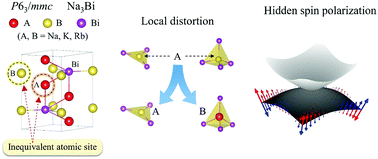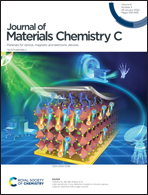Designing Dirac semimetals with a honeycomb Na3Bi-lattice via isovalent cation substitution†
Abstract
Functionality driven materials design for crystalline symmetry enabled quantum phases such as Dirac semimetals often faces the challenge of stabilizing a crystal structure with targeted functionality. Here, we propose an iso-symmetry isovalent cation substitution approach for stabilizing a honeycomb (P63/mmc) lattice analogous to Na3Bi that was predicted as the first Dirac semimetal with conical linear band dispersion at the Fermi level protected by high-order rotational symmetry. Such isovalent substitution on the inequivalent cation sites in dynamically unstable Na3Bi (P63/mmc) maintains the crystalline symmetry and reduces the strain energy, leading to the prediction of three dynamically stable compounds K2NaBi, Rb2NaBi and Rb2KBi that are also thermodynamically stable against disproportionation into the competing phases. Electronic structure analysis reveals that the predicted ternaries have Dirac cones mainly consisting of Bi-6p and metal s states at the Fermi level, with interesting hidden spin textures. Our study suggests a rational approach for designing functional materials, and could stimulate future predictions of new stable materials based on inequivalent-site isovalent-cation substitution.

- This article is part of the themed collection: Journal of Materials Chemistry C HOT Papers


 Please wait while we load your content...
Please wait while we load your content...